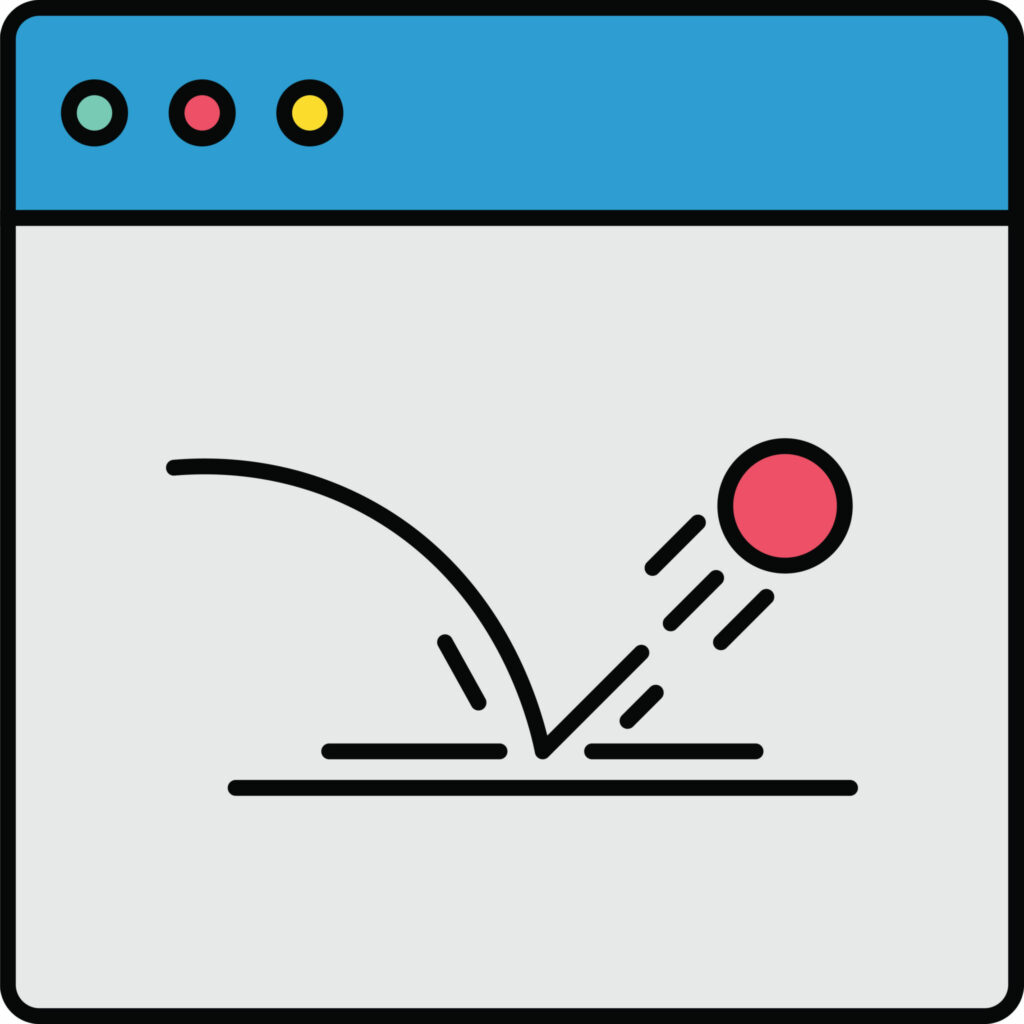Picture this: you’ve spent countless hours perfecting your website. Your copy is compelling, your images are eye-catching, and your products or services are top-notch. But here’s the problem: your website’s bounce rate is sky-high. Visitors are leaving your site as soon as they arrive, and you’re left scratching your head wondering what went wrong. Sound familiar?
Bounce rate is a metric that measures the percentage of visitors who leave your site after visiting just one page. In other words, they “bounce” off your site without taking any further action. It’s a critical metric to track because it can tell you whether your website is engaging enough to keep visitors interested. But the million-dollar question is: what is a good bounce rate?
In this article, we’re taking a deep dive into the subject of bounce rates. We’ll cover the definition of bounce rate, how it’s calculated, what a healthy bounce rate looks like for different types of websites, and how to improve your bounce rate. By the end of this blog post, we’ll make sure you have a good understanding of bounce rates and how to improve them – so that you can finally start getting the most out of your website. So, let’s get started!
What is a bounce rate?
In web analytics, a bounce rate refers to the percentage of website visitors who leave a website after only viewing a single page. In other words, the visitor doesn’t interact with any other pages on the website before exiting, usually back to the search engine results page where they found the website in the first place.
A high bounce rate can be a red flag because it suggests that your visitors are not finding the answers they’re looking for on your website and are forced to look elsewhere. A low bounce rate, on the other hand, indicates that a website is a valuable source of information for visitors and prompts them to explore what else the website has to offer.
How is Bounce Rate Calculated?
Bounce rate is the number of single-page sessions divided by the total number of sessions on a website. A single page session occurs when a user only views one page on a website before leaving. For example, if a website has 1,000 sessions in a month and 500 of those sessions only viewed one page before leaving, the bounce rate for that site would be 50%.
Why is it Important to Track Bounce Rates?
Tracking bounce rates is important because it can provide valuable insights into how visitors interact with a website. As we mentioned before, a high bounce rate may indicate that visitors are not finding what they are looking for on a website, or that the website is not engaging enough to encourage visitors to explore further.
The main objective of a business website is usually to drive conversions, so if its bounce rate is generally high across multiple pages, those pages probably aren’t leading to many sales.
By tracking bounce rates over time, website owners can identify trends and make changes to improve user engagement and overall website performance.
What is the average bounce rate for websites?
The average bounce rate for websites can vary widely depending on the industry and the type of website. According to a benchmark report by Contentsquare, the normal bounce rate across industries is 47%.
However, this can range from as low as 20% for e-commerce websites to as high as 90% for certain page types like dictionaries or blogs.
As a general guideline, here are some bounce rate benchmarks by industry (provided by Custom Media Labs):
- E-commerce & retail: 20-45%
- B2B websites: 25-55%
- Lead generation websites: 30% – 55%
- Landing pages: 60% – 90%
- Blogs, news websites, dictionaries, etc.: 65-90%
Remember, these benchmarks are not set in stone and can vary depending on many factors, including the quality of your content and how well you’re targeting your audience.

Where Bounce Rate Gets Complicated
To clarify, a high bounce rate doesn’t always mean that your website is performing poorly. For example, if you have a landing page designed to capture leads, a high bounce rate may actually be a good thing if visitors are filling out the lead form.
If you’re worried about whether your landing page is performing as it should, go check out our blog on landing page optimization strategies to boost your conversion numbers.
In general, it’s best to aim for a low bounce rate because it indicates that visitors are engaged with your site and are more likely to convert. Still, you should keep in mind that the bounce rate is just one metric among many. It should always be considered in context with other metrics such as average session duration, pages per session, etc. That way, you can have a good understanding of your website’s overall performance, not just one statistic that may or may not be influenced by factors out of your control.
What is a Good Bounce Rate?
When it comes to bounce rate, what’s considered “good” can vary depending on your website’s goals, industry, and audience. But generally speaking, the lower the bounce rate, the better.
As far as concrete numbers go, you should aim for a bounce rate of 30% – 40% (or less), but the ideal number will depend on what type of website you have and what you’re trying to achieve. In general, the best way to determine what a good bounce rate is for your website is to track your metrics over time and see how they compare to industry benchmarks.
What Causes a High Bounce Rate?
A high bounce rate can be frustrating for website owners, but it’s important to understand the root causes in order to take steps to improve it. Here are some common reasons why your bounce rate might be high:
Slow website speed
In today’s digital world, site visitors are becoming less and less tolerant of slow-loading web pages. If your website takes too long to load, visitors are likely to abandon it and look for a faster alternative. According to Google, 90% of mobile site visitors will leave if a page takes longer than 5 seconds to load. Slow website speed can be caused by a variety of factors, such as large image files, too many plugins, or poor server performance.
Poor website design
A website that is difficult to navigate or has an unappealing design can be a deterrent for site visitors. If your website is cluttered, lacks clear calls to action, or has confusing navigation, visitors may become frustrated and leave after only viewing a single page. A clean, modern website design that is optimized for user experience can help keep visitors engaged and on your site for longer.
Lack of engaging content
If your website content is boring, irrelevant, or doesn’t satisfy search intent, visitors are unlikely to stick around. Your web page should provide value and be engaging enough to capture the interest of your target audience. By creating high-quality content that speaks to your visitors’ needs, interests, and pain points, you can increase the chances of keeping them on your site and reducing your single page sessions.
Headings are usually what draws a visitor’s attention first, so vague headings that don’t properly convey the big picture of a page or section are likely to cause visitors to “bounce.” Similarly, a page that lacks clear calls to action will confuse visitors. They won’t know what the website asks of them or why they should answer that call. Thus, they’ll likely bounce from that page instead of moving further down your marketing funnel.
Irrelevant traffic sources
The source of your website traffic can also have an impact on your bounce rate. What does this mean? Traffic sources are essentially what bring people to your website. Examples of traffic sources include search results, social media platforms, and paid ads.
If your website is getting a lot of traffic from sources that aren’t relevant to what you’re offering, then your bounce rate could be higher than what you’d like. For example, if someone clicks on your link from a paid ad and then quickly realizes that what they’re looking for isn’t actually what you’re offering, they’ll likely bounce right away. Need help identifying a good CTR for your campaigns? You’ll find everything you need to know about what makes a good CTR here.
Technical issues
Technical issues such as broken links, 404 errors, or server downtime can also cause a high bounce rate. If your site visitors encounter technical issues while browsing your site, they’re likely to leave and not return. Regularly monitoring your site using tools like Google Analytics can help you identify technical issues and address them before they become a problem.
By addressing these common causes of a high bounce rate, you can improve your website’s performance and increase engagement with your target audience.

6 Fundamental Ways to Improve Your Bounce Rate
Improving your website’s bounce rate can lead to better engagement and conversions. Here are some tips to help you reduce your bounce rate:
1. Improve Website Speed
Slow website speed is one of the main causes of high bounce rates. Site visitors are likely to leave your site if it takes too long to load. To improve your website speed, you can:
- Optimize your images and videos to reduce file size
- Use a content delivery network (CDN) to speed up loading times
- Minimize HTTP requests by using CSS and JavaScript files efficiently
To test your site speed, try a tool like GTMetrix, which will let you analyze several aspects of your site’s speed for free.
2. Make Your Website Mobile-Friendly
Mobile devices generate over half of all web traffic, so it’s essential that your website is optimized for mobile. If your website isn’t optimized for mobile, visitors may leave immediately. To make your site mobile-friendly, you can:
- Utilize responsive design that adapts to different screen sizes
- Ensure your fonts are easy to read on mobile devices
- Simplify your navigation for mobile users
3. Improve Website Design
A poorly designed website can be a major turn-off for visitors. A few ways to improve website design are:
- Use a clean and simple layout that’s easy to navigate
- Choose a color scheme that’s visually appealing and consistent throughout your site
- Use high-quality images and graphics (that are relevant to your content)
4. Provide High-Quality Content
Engaging content can keep visitors on your site longer and reduce your bounce rate. To create high-quality content, you can:
- Research your audience and write content that’s relevant to their interests and needs
- Use headings, subheadings, and bullet points to make your content easy to read
- Include visuals such as images and videos to make your content more engaging
5. Target Relevant Traffic Sources
To reduce your bounce rate, it’s essential to target relevant traffic sources.
There will be certain traffic sources that are more relevant to what your site offers, so it’s important to focus on those rather than ones that are less relevant. For example, an e-commerce website that sells products primarily targeted to young adults will have better luck advertising on TikTok than Facebook, since TikTok has a higher percentage of young adult users.
By targeting traffic that is interested in your site’s content, you’ll increase the likelihood of visitors staying on your site longer. You can also consider utilizing paid ads to target specific demographics and interests, ensuring that your site’s content is relevant to those who visit it.
6. Improve User Experience
UI/UX is one of the most important factors that can make or break your website’s bounce rate. If visitors find it difficult to navigate your site or don’t understand what they are seeing, it is HIGHLY unlikely they will stick around for more than a few seconds.
To improve user experience, you can:
- Check that all website links are working correctly and redirecting visitors to the right page.
- Simplify your navigation menu to make it easier for users to find what they are looking for.
- Use clear calls-to-action to guide visitors to take the next step on your site.
- Utilize internal links so that your traffic is being directed to another page on your website.

Bonus: Expert-Level Ways to Reduce Bounce Rate
In addition to what was discussed above, there are some more advanced strategies you can use to reduce your bounce rate. These include:
Implement a Live Chat Tool
Live chat is a great way to engage your users and provide them with instant support. By implementing a live chat tool, you can help your users get the answers they need quickly and easily. This can improve user experience and reduce bounce rate.
A/B Testing
A/B testing involves creating two versions of a web page and testing them to see which one performs better. By testing different versions of your web pages, you can identify which elements are causing users to bounce and optimize your website accordingly. This can help reduce bounce rate and improve user engagement.
Exit Pop-Ups
Exit pop-ups are a controversial but effective way to reduce bounce rate. When a user tries to leave your website, an exit pop-up appears, offering them a discount or an incentive to stay on your website. This can help retain users and reduce bounce rate. These popups can be controversial because they can be seen as intrusive, but as long as you use them sparingly, they can be a great way to keep people on your website.
By implementing these expert-level strategies, you can reduce your website’s bounce rate and improve user engagement. One tried and true approach to finding great success in your campaign is to optimize your strategy, by starting with a buyer persona. We break the concept down in our digital marketing best practices blog, you can read it here.
Keep in mind that reducing bounce rate is an ongoing process, and it’s important to continually test and optimize your website to achieve the best results.
Final Thoughts on Bounce Rate
In conclusion, understanding and improving your website’s bounce rate is crucial for attracting and retaining web traffic. By optimizing your site content, improving page speed, and targeting relevant traffic sources, you can decrease your bounce rate and increase engagement with your audience. Remember, a high bounce rate doesn’t always indicate poor performance, and it’s essential to consider the context of your website and its goals. By regularly monitoring your bounce rate and implementing these tips, you can continue to improve your website’s performance and attract more engaged visitors.
Frequently Asked Questions
Is 80% bounce rate good?
Unfortunately, an 80% bounce rate is not great. It means that 80% of your site visitors left your website after viewing only one page. It’s an indication that your website is failing to engage visitors with its content, design, or user experience. The average bounce rate varies by industry, but generally speaking, a bounce rate below 40% is considered good.
Is a 10% bounce rate good?
Technically, yes. But, a 10% bounce rate is nearly impossible to achieve. If your analytics data shows that a webpage has a 10% bounce rate, double-check that it is aggregating the numbers correctly and that all of your website links are working properly.
Why would a bounce rate be low?
A low bounce rate means that visitors are exploring your site and visiting multiple pages. Some reasons for a low bounce rate include engaging site content, clear navigation, a user-friendly design, and relevant traffic sources.
Is a high or low bounce rate good?
A low bounce rate is generally considered good because it means that visitors are exploring your site and finding value in your content. However, what is considered a good bounce rate varies by industry, website type, and other factors. Generally, a bounce rate below 40% is considered good.
What does a high bounce rate mean?
A high bounce rate means that a large percentage of your site visitors leave your site after viewing a single page. This could indicate that your site content, design, or user experience needs improvement, or that the traffic sources driving visitors to your site are not relevant.
Why is my bounce rate suddenly so low?
A sudden decrease in bounce rate could be due to a variety of factors, including changes to your site content or design, the implementation of paid ads, or a change in traffic sources. However, it’s important to analyze your site’s data to understand the specific reason for the decrease. A low bounce rate may not always be a good thing, as it could indicate that visitors are not finding the information they need and are instead spending more time searching for it, resulting in longer session durations.






